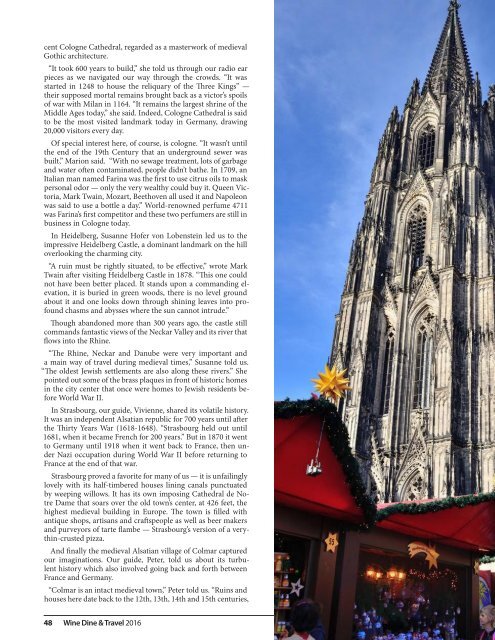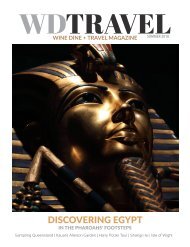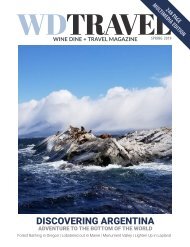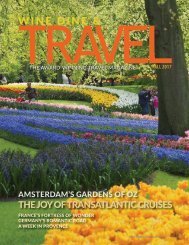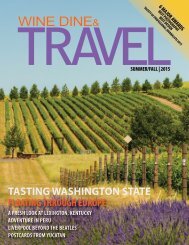WINE DINE & TRAVEL MAGAZINE ISSUE 2 2016 issue
The travel magazine produced and written by award winning travel journalists. This issue feature a trip Down Under in search of Hobbits in New Zealand.
The travel magazine produced and written by award winning travel journalists. This issue feature a trip Down Under in search of Hobbits in New Zealand.
Create successful ePaper yourself
Turn your PDF publications into a flip-book with our unique Google optimized e-Paper software.
cent Cologne Cathedral, regarded as a masterwork of medieval<br />
Gothic architecture.<br />
“It took 600 years to build,” she told us through our radio ear<br />
pieces as we navigated our way through the crowds. “It was<br />
started in 1248 to house the reliquary of the Three Kings” —<br />
their supposed mortal remains brought back as a victor’s spoils<br />
of war with Milan in 1164. “It remains the largest shrine of the<br />
Middle Ages today,” she said. Indeed, Cologne Cathedral is said<br />
to be the most visited landmark today in Germany, drawing<br />
20,000 visitors every day.<br />
Of special interest here, of course, is cologne. “It wasn’t until<br />
the end of the 19th Century that an underground sewer was<br />
built,” Marion said. “With no sewage treatment, lots of garbage<br />
and water often contaminated, people didn’t bathe. In 1709, an<br />
Italian man named Farina was the first to use citrus oils to mask<br />
personal odor — only the very wealthy could buy it. Queen Victoria,<br />
Mark Twain, Mozart, Beethoven all used it and Napoleon<br />
was said to use a bottle a day.” World-renowned perfume 4711<br />
was Farina’s first competitor and these two perfumers are still in<br />
business in Cologne today.<br />
In Heidelberg, Susanne Hofer von Lobenstein led us to the<br />
impressive Heidelberg Castle, a dominant landmark on the hill<br />
overlooking the charming city.<br />
“A ruin must be rightly situated, to be effective,” wrote Mark<br />
Twain after visiting Heidelberg Castle in 1878. “This one could<br />
not have been better placed. It stands upon a commanding elevation,<br />
it is buried in green woods, there is no level ground<br />
about it and one looks down through shining leaves into profound<br />
chasms and abysses where the sun cannot intrude.”<br />
Though abandoned more than 300 years ago, the castle still<br />
commands fantastic views of the Neckar Valley and its river that<br />
flows into the Rhine.<br />
“The Rhine, Neckar and Danube were very important and<br />
a main way of travel during medieval times,” Susanne told us.<br />
“The oldest Jewish settlements are also along these rivers.” She<br />
pointed out some of the brass plaques in front of historic homes<br />
in the city center that once were homes to Jewish residents before<br />
World War II.<br />
In Strasbourg, our guide, Vivienne, shared its volatile history.<br />
It was an independent Alsatian republic for 700 years until after<br />
the Thirty Years War (1618-1648). “Strasbourg held out until<br />
1681, when it became French for 200 years.” But in 1870 it went<br />
to Germany until 1918 when it went back to France, then under<br />
Nazi occupation during World War II before returning to<br />
France at the end of that war.<br />
Strasbourg proved a favorite for many of us — it is unfailingly<br />
lovely with its half-timbered houses lining canals punctuated<br />
by weeping willows. It has its own imposing Cathedral de Notre<br />
Dame that soars over the old town’s center, at 426 feet, the<br />
highest medieval building in Europe. The town is filled with<br />
antique shops, artisans and craftspeople as well as beer makers<br />
and purveyors of tarte flambe — Strasbourg’s version of a verythin-crusted<br />
pizza.<br />
And finally the medieval Alsatian village of Colmar captured<br />
our imaginations. Our guide, Peter, told us about its turbulent<br />
history which also involved going back and forth between<br />
France and Germany.<br />
“Colmar is an intact medieval town,” Peter told us. “Ruins and<br />
houses here date back to the 12th, 13th, 14th and 15th centuries,<br />
48 Wine Dine & Travel <strong>2016</strong>


